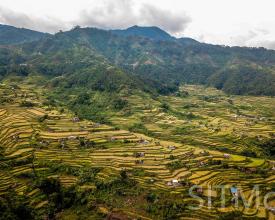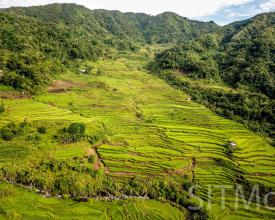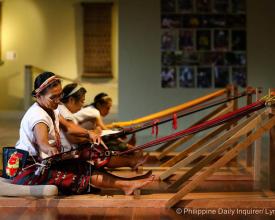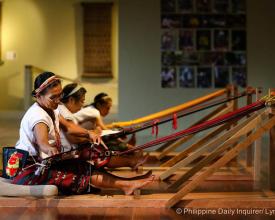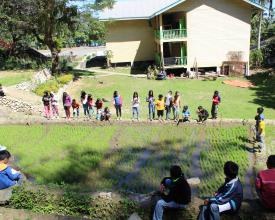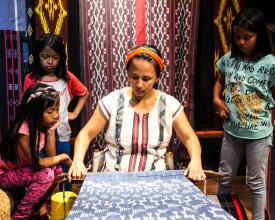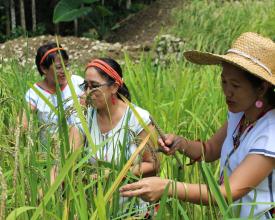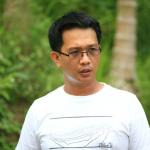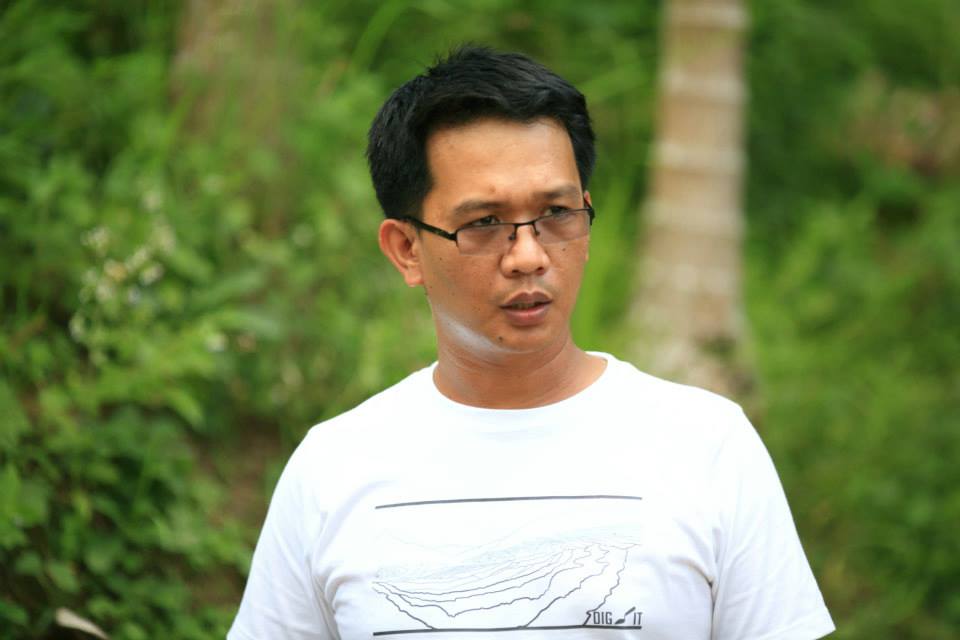
Involving youth through heritage education in the conservation of the Rice Terraces of the Philippine Cordilleras, Philippines
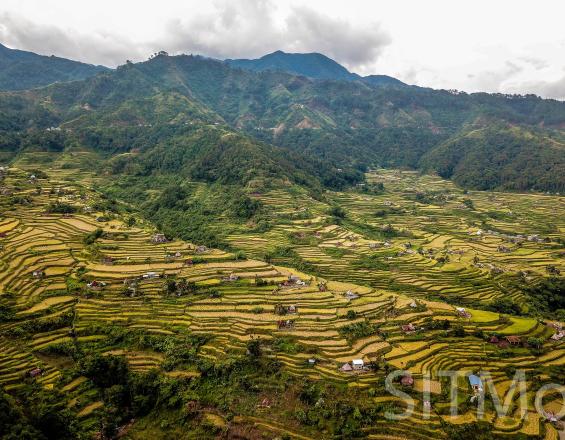
The Rice Terraces of the Philippine Cordilleras located in the mountain areas of Northern Luzon, were inscribed in the World Heritage (WH) List under criteria (iii), (iv) and (v) in 1995, as an organically evolved, living cultural landscape of outstanding universal value. Produced by the Ifugao ethnic group, the terraces are tangible testimonies of intergenerational transmission of their Indigenous worldview which represents harmony between humankind and the environment. In 2001, the property was put in the WH List in Danger due to deterioration caused by extreme weather conditions and socio-cultural changes, notably outmigration, loss of Indigenous knowledge and erosion of customary social institutions. The Save the Ifugao Terraces Movement (SITMo), a grassroots non-profit organization, is partnering with local and national governments, and scientific institutions for raising youth awareness on the interlinked cultural and natural values of the Rice Terraces through heritage education enabling their conservation.
Context
Challenges addressed
The main challenge is the poor state of conservation of the Ifugao Rice Terraces that has been linked to culturally-insensitive public policies and inadequate planning, which do not take into consideration the natural and human dimensions for conserving them. The terraces’ deterioration is due to several factors, including environmental (extreme weather), social (outmigration, loss of traditional knowledge, erosion of customary social institutions), and economic (subsistence agriculture, lack of alternative income). The conviction of SITMo is that the conservation of the Ifugao Rice Terraces is largely dependent on the continuity of the Ifugao Indigenous knowledge system, which mastered the natural environment creating a unique landscape and a distinct way of life. Hence, the work focuses on youth education, in order to pass on the traditional knowledge, based on interlinked natural and cultural values, and that would allow the sustainable development of Ifugao Indigenous people.
Location
Process
Summary of the process
In order to develop a sustainable strategy for the conservation of the Rice Terraces of Ifugao, there was a need to acknowledge the value of the Indigenous Ifugao culture. The rice terraces as heritage, are the product of hundreds of years of traditional knowledge and intergenerational transmission of a particular worldview. Developing partnerships between local activist groups like SITMo and the government (BB1), and scientific institutions that can continue research and back local traditional knowledge as a resource for biodiversity conservation (BB2) is instrumental for developing a curriculum that integrates Ifugao culture in the educational system (BB4). The establishment of a multi-functional community centre like the Indigenous Peoples Education Centre (BB3) creates the space and platform for a sustainable collaboration between partners, local communities, and continuous advocacy for the conservation of the terraces and Ifugao culture.
Building Blocks
Developing a multi-stakeholder network (farmers, community members, government agencies and the academe)
Involving all stakeholders in the conservation of the Rice Terraces cultural landscape required the strengthening of existing networks, where the traditional knowledge behind the construction and maintenance of the terraces, carried by the Ifugao people played a pivotal role for their recovery and sustainable conservation. As a community organization where 99% of its members are Ifugaos themselves and based on the Philippine Rural Reconstruction Movement (PRRM), a national NGO working on community development projects, SITMo had strong foundations for the development of alliances. It developed partnerships with the national authority and the local governments in order to involve local communities in the process of recovering the terraces and develop sustainable strategies for their long-term conservation. SITMo focused on organizing farmers in the different World Heritage clusters to discuss issues confronting the terraces in focus groups with the communities. All along, archaeological and ethnographic research has been conducted continuously by SITMo in cooperation with academic institutions namely UCLA, the University of the Philippines, and Ifugao State University.
Enabling factors
- SITMo founded in 1999 as a grass-roots initiative to protect the terraces and recover the traditional knowledge and heritage of the Ifugao Indigenous People.
- The inclusion of the Rice Terraces of the Philippines Cordillera in the World Heritage List in Danger by a request of the government of the Philippines in 2001, allowed for the mobilization of international cooperation to support the conservation efforts of the terraces.
- Recognized need of involving local communities in the terraces’ conservation.
Lesson learned
- Importance of the establishment of long-term objectives based on a long-term strategy which was decided to be focused on education.
- Need of partnering with the Ministry of Education and other political actors.
Creation of collaborative research projects on Indigenous and Local Knowledge
SITMo has developed partnership with local scientific institutions like the Ifugao State University, which is working with the FAO Globally Important Agricultural Heritage System (GIAHS) designation and has established the Ifugao Rice Terraces GIAHS Research and Development Center. Furthermore, connected to this initiative, SITMo is working in cooperation with the Ifugao State University and the Taiwan Ministry of Science and Technology and the National Chengchi University of Taiwan in the project “Center for Taiwan-Philippines Indigenous Knowledge, Local Knowledge and Sustainable Development”, where partner institutions are exploring together the sustainable safeguarding and transmission of their Indigenous knowledge through exchange and collaborative research, which would enable local communities to develop sustainably. A long-term partnership with the Department of Anthropology at the University of California, Los Angeles (UCLA) has been established in 2012 to undertake archaeological investigations in the terraces, leading to the establishment of community heritage galleries and publication of scientific articles.
Enabling factors
- GIAHS designation of the Rice Terraces (2004)
- The local Ifugao State University is engaged in research and cooperation focused on the rice terraces, agroforestry and biodiversity conservation
- The Department of Education embarked on a major overhaul of the curriculum where Indigenous knowledge and local Ifugao culture is to be integrated in all levels of K to 12. Research on traditional knowledge was required.
- Common challenges with neighboring countries and other Indigenous communities
Lesson learned
- Involving research in the conservation of the Rice Terraces and the engagement of the youth and the community at large in the endeavor are mutually beneficial (for the research institutes and the local communities)
- The interface of traditional knowledge learning through community elders and the formal schools through formally trained teachers can be conflicting at times so long-term strategies are to be put in place.
- Administrative bureaucracy can be difficult for non-government organizations to work with government agencies and universities but patience is the key to success.
Resources
Re-valorization of the Indigenous culture through its integration in the education system
The Ifugao Rice Terraces are maintained by families, not merely as production areas for a staple crop but also for the sentimental reason that these properties have been passed down from their ancestors. The maintenance of the rice terraces reflects primarily a cooperative approach of the whole community which is based on detailed knowledge of the rich biodiversity existing in the Ifugao agro-ecosystem, a finely tuned annual system respecting the lunar cycle, zoning and planning, extensive soil and water conservation, mastery of the complex pest control regime based on the processing of a variety of herbs, accompanied by religious rituals. Yet, this knowledge is under threat due to socio-cultural changes and the lack of involvement of the youth, which is attracted by the urban globalized way of life. In order to conserve the terraces, the Ifugao culture needs to be recognized and the Ifugao Indigenous Knowledge passed down to the next generation. The sustainable strategy proposed by SITMo is to integrate culture and heritage in the official curriculum so the Ifugao culture can be safeguarded.
Enabling factors
In 2013, the Philippines passed legislations for the implementation of Indigenous Peoples Education (IPED.) Long before this, SITMo had been on the forefront of the advocacy to integrate traditional knowledge in the formal schools’ curriculum to address the deterioration of the rice terraces and everything it stood for. The advocacy continues as IPED is now institutionalized, integrating traditional knowledge, mother tongue and local history into the different levels of the educational system.
Lesson learned
Community consultations are necessary tools in this process. Community elders, culture bearers and even political leaders are involved from the first consultations up to the validation of produced learning materials for use in schools. The Philippine government provides for a Free and Prior Informed Consent Process (FPIC) which has to be followed.
The educational system in the Philippines is a continuing relic of a colonial strategy to conquer the Indigenous. The Americans put in place an educational system that lasted more than a hundred years, long enough to erase one’s adherence to one’s ethnic identity and embracing a homogenous sense of nationalism. Education was standardized, values were nationalized. Textbooks preached that being a farmer is the consequence of not going to school and that non-Christian beliefs are the ways of savages. Indigenous cultures were demonized to the point that young people actually abhor the idea of being identified as one. An overhaul of the educational system can change this. Decolonizing education is the way forward.
Establishment of a multi-functional community knowledge centre
SITMo has created the Indigenous Peoples Education (IPED) Centre in order to mainstream Indigenous knowledge in the formal education system and serve as a resource centre for Ifugao heritage conservation. The centre is a work in progress as SITMo is currently working with the Department of Education in the development of learning materials that include traditional knowledge, local history and language. The centre is composed of SITMo’s peoples’ organization including farmers, traditional weavers, community volunteers, culture bearers and heritage workers. IPED functions now as a Community Heritage Centre, Resources Centre, Community Museum, and is inspiring other provinces to create their own.
Enabling factors
- Partnerships with local governments, other government agencies and community stakeholders.
- SITMo members are also part of the communities and are involved in diverse communal roles.
Lesson learned
The Centre, started out as a single showroom for the artefacts collected during the archaeological digs. The original purpose was merely to show members of the community the findings of the archaeological project. The need to broaden the educational implications of the project required us to include related literature and other artefacts which resulted to a mini-library on Ifugao culture, a gallery on textiles and a photo gallery of the World Heritage Site's clusters and GIAHS sites. The Centre also became a venue for community and teachers’ trainings on heritage education and an educational tour destination for Ifugao students. The Centre became multi-functional as Community Heritage Centre, Resources Centre, Community Museum hosting a diversity of activities and covering different needs for local communities. Being flexible and adapting to community needs is important.
Training high-school teachers on traditional knowledge and local culture
In order to integrate Ifugao culture in the formal school curriculum, teachers need to receive capacity building on the Ifugao culture. Teachers, most of Ifugao origin, have forgotten the value-system of their ancestors due to the modern education system. Some have been trained outside of the Ifugao region. The objective is to train teachers in integrating culture in mathematics, social sciences, and all courses, and design learning materials, modules which include the Ifugao culture as a cross-cutting theme. Teachers’ trainings on local curriculum development and coming up with learning modules are on-going.
Enabling factors
The national government had undertaken a change in the education system to allow locally-based curriculums (IPED).
Lesson learned
Ifugao culture does not need to be taught as a separate theme, but can be a cross-cutting theme for the whole curriculum.
Impacts
Coordinated efforts of national, provincial and municipal governments, international funds and local communities participation have succeeded in removing the Rice Terraces from the WH List in Danger in 2012. Yet, the terraces are still in a vulnerable situation. SITMo promotes investing in education to raise awareness of heritage values in order to achieve sustainability. So far, concrete social and economic impacts are:
- Educational system change: Culture is mandatory for the education department. Traditional knowledge is included in WH conservation, and Ifugao culture, history and language are integrated in the official curriculum.
- Raised awareness: heritage value of the terraces becomes a daily life discussion of Ifugao people.
- Acquisition of additional funding for advocacy, awareness raising and conservation activities.
Beneficiaries
Local communities in Ifugao, Ifugao youth and Ifugao community at large
Sustainable Development Goals
Story

The overall goal of the SITMo is to help improve the economic status of rice terraces farmers as a way of effecting continuity and conservation of the terraced landscape. SITMo always believed that conservation of the terraces is primarily anchored on the economic relations of people and the cultural landscape. While the terraces were constructed at a time of relative isolation of the Ifugaos, its economic function remained constant through the generations and through all the socio-political upheavals its history has gone through. Rice became the center of the cultural development of the Ifugao. Now, the terraces are left to an aging population of farmers whose traditional knowledge has no one to pass on to. An aging farmer said, “The remaining terraces you see are mere shadows of what we had in our childhood. During our time, people came together to work the fields. Each is expected to help in the stone walling, the planting, the harvesting. Our old priests prayed the rituals and offered sacrifices to the gods, the same gods our ancestors prayed to. The community gathered to work, to celebrate, to help each other. The seasons can bring down a terrace wall, too much rain, too much sun, we had those during our time - but we keep putting them back, stone by stone, paddy field after paddy field. We had to keep the terraces alive, we need to flood the pond fields for the next planting season. It’s what we did, just as the ancients taught us".
In our youth meetings, one teenager summarized all their concerns: “As young Ifugaos, we have the responsibility to take care of our heritage. Our rice terraces, our forests, the values and the Indigenous knowledge that come with all these things. Yet we are also children of the modern times. While our elders tell us to take care of the land, it is no longer enough to sustain us. Our population is getting bigger but the land is not getting any wider. While we want to keep our culture as Ifugaos, we also need to adapt to the realities of the modern times".
By comparing and assessing where the young and old are coming from, we realized that it doesn’t have to be a choice between staying put and moving forward. Culture has to change for it to survive yet it doesn’t mean totally leaving behind tradition. Compromises are necessary for culture change and conservation to work. Ifugao culture is what we have now. It can either change towards total forgetfulness of the past or the past adapting to the present. (Marlon Martin, SITMo)


